President Niceto Alcala-Zamora | Name Manuel Azana | |
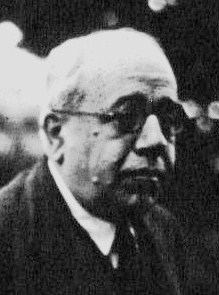 | ||
Prime Minister Santiago Casares QuirogaDiego Martinez BarrioJose GiralFrancisco Largo CaballeroJuan Negrin Preceded by Niceto Alcala-ZamoraActing president Diego Martinez Barrio Preceded by Juan Bautista Aznar Cabanas | ||
V deo in dito del discurso de manuel aza a desde el ayuntamiento de barcelona 1938
Manuel Azaña Díaz ([maˈnwel aˈθaɲa]; 10 January 1880 – 3 November 1940) was the second Prime Minister of the Second Spanish Republic (1931–1933), and later served again as Prime Minister (1936), and then as the second and last President of the Republic (1936–1939). The Spanish Civil War broke out while he was President. With the defeat of the Republic in 1939, he fled to France, resigned his office, and died in exile shortly afterwards.
Contents
- V deo in dito del discurso de manuel aza a desde el ayuntamiento de barcelona 1938
- Himno de riego presidente manuel aza a diaz mpeg2video
- His early career
- In the government
- Presidency
- Last days
- Azaas writings
- References

Himno de riego presidente manuel aza a diaz mpeg2video
His early career
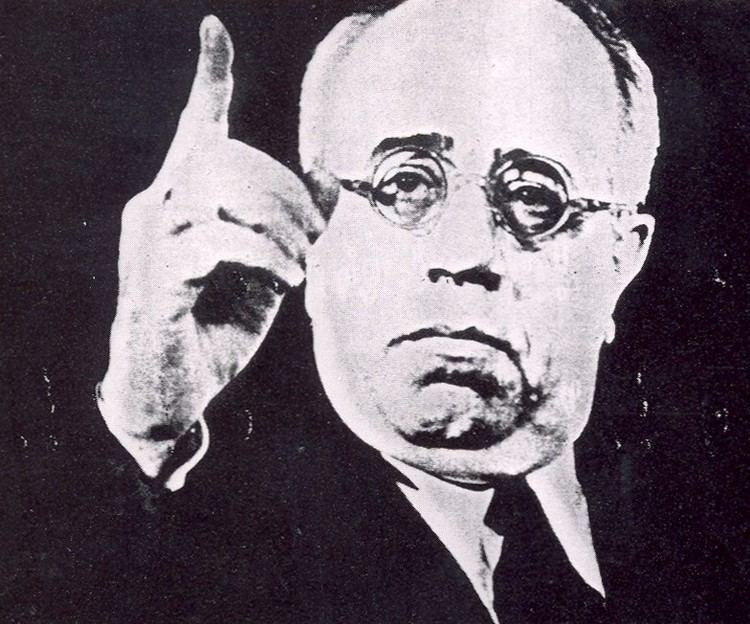
Born into a rich family, Manuel Azaña Díaz was orphaned at a very young age. He studied in the Universidad Complutense, the Cisneros Institute and the Agustinos of El Escorial. He was awarded a Lawyer's licence by the University of Zaragoza in 1897, and a doctorate by the Universidad Complutense in 1900.
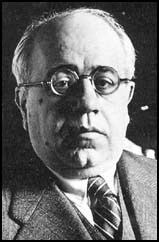
In 1909 he achieved a position at the Main Directorate of the Registries and practiced the profession of civil law notary, and traveled to Paris in 1911. He became involved in politics and in 1914 joined the Reformist Republican Party led by Melquíades Álvarez. He collaborated in the production of various newspapers, such as El Imparcial and El Sol. During World War I he covered operations on the Western Front for various newspapers. His treatment was very sympathetic to the French, and he may have been subsidized by French military intelligence. Afterwards he directed the magazines Pluma and España between 1920 and 1924, founding the former with his brother-in-law Cipriano Rivas Cherif. He was secretary of the Ateneo de Madrid (1913–1920), becoming its president in 1930. He was a candidate for the province of Toledo in 1918 and 1923, but lost on both occasions. In 1926 he founded the Acción Republicana ("Republican Action") party with José Giral.
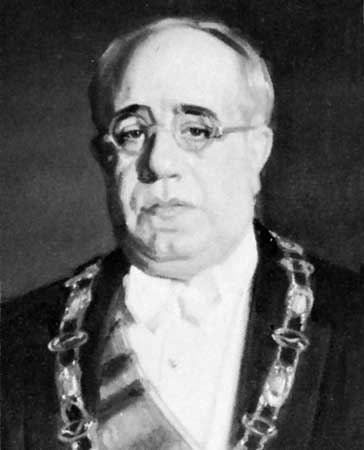
A strong critic of the dictatorship of Primo de Rivera, Azaña published an energetic manifesto against the dictator and King Alfonso XIII in 1924. In 1930, he was a signatory of the "Pact of San Sebastián", which united all the republican and regionalist parties in Spain against Primo de Rivera and the King.
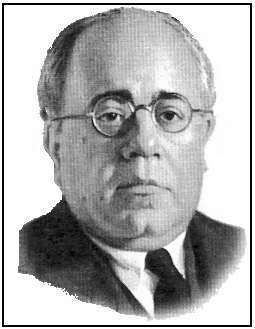
On 12 April 1931, republican candidates swept the municipal elections. This was seen as repudiation of Primo de Rivera and the monarchy. Two days later, the Second Spanish Republic was proclaimed.
In the government

Niceto Alcalá-Zamora, prime minister of the provisional government of the Republic, named Azaña Minister of War on 14 April. Alcalá-Zamora resigned in October, and Azaña replaced him as prime minister. When the new constitution was adopted on 9 December, Azaña continued as prime minister, leading a coalition of left-wing parties, including his own Acción Republicana and the Socialists (PSOE), while Alcalá-Zamora became President of the Republic.

Azaña pursued some of the major reforms anticipated by the republican program. He introduced work accident insurance, reduced the size of the Spanish Army, and removed some monarchist officers. He also moved to reduce the power and influence of the Roman Catholic Church, abolishing Church-operated schools and charities, and greatly expanding state-operated secular schools. The Spanish legislature, the Cortes, also enacted an agrarian reform program, under which large private landholdings (latifundia) were to be confiscated and distributed among the rural poor.
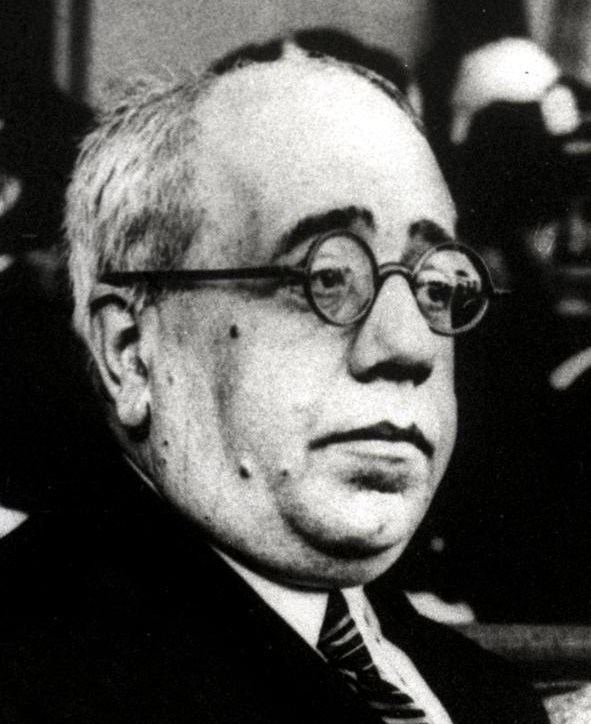
However, Azaña was a "middle-class republican", not a socialist. He and his followers were not enthusiastic for this program. The agrarian law did not include state-funded collective farms, as the Socialists wanted, and was not enacted until late 1932. It was also clumsily written, and threatened many relatively small landholders more than the latifundists. The Azaña government also did very little to carry it out: only 12,000 families received land in the first two years.
In addition, Azaña did little to reform the taxation system to shift the burden of government onto the wealthy. Also, the government continued to support the owners of industry against wildcat strikes or attempted takeovers by militant workers, especially the anarcho-syndicalists of the Confederación Nacional del Trabajo (National Confederation of Labor or CNT). Confrontation with the CNT erupted in bloody violence at Casas Viejas (now Benalup), Castilblanco, and Arnedo.
Meanwhile, Azaña's extreme anti-clerical program alienated many moderates. In local elections held in early 1933, most of the seats went to conservative and centrist parties. Elections to the "Tribunal of Constitutional Guarantees" (the Republic's "Supreme Court") followed this pattern.
Thus Azaña came into conflict with both the right and far left. He called a vote of confidence, but two-thirds of the Cortes abstained, and Alcalá-Zamora ordered Azaña's resignation on 8 September 1933. New elections were held on 19 November 1933.
These elections were won by the right-wing Confederación Española de Derechas Autónomas (CEDA) and the centrist Radical Republican Party. Radical leader Alejandro Lerroux became prime minister. Azaña temporarily withdrew from politics and returned to literary activity.
Azaña's self-imposed political retreat lasted only a short while; in 1934 he founded the Republican Left party, the fusion of Acción Republicana with the Radical Socialist Republican Party, led by Marcelino Domingo, and the Organización Republicana Gallega Autónoma (ORGA) of Santiago Casares Quiroga.
On 5 October 1934, the PSOE and Communists attempted a general left-wing rebellion. The rebellion had a temporary success in Asturias and Barcelona, but was over in two weeks. Azaña was in Barcelona that day, and the Lerroux-CEDA government tried to implicate him. He was arrested and charged with complicity in the rebellion.
In fact Azaña had no connection with the rebellion, and the attempt to convict him on spurious charges soon collapsed, giving him the prestige of a martyr. He was released from prison in January 1935. Azaña then helped organize the Frente Popular ("Popular Front"), a coalition of all the major left-wing parties for the elections of 16 February 1936.
The Front won the election, and Azaña became prime minister again on 19 February. His government included the PSOE and Communists. This alarmed conservatives, who remembered their attempt to seize power only 17 months earlier. The Azaña government proclaimed an immediate amnesty for all prisoners from the rebellion, which increased conservative concerns. Socialists and Communists were appointed to important positions in the Assault Guard and Civil Guard.
Also, with the Popular Front victory, radicalized peasants led by the Socialists began seizing land on 25 March. Azaña chose to legitimize these actions rather than challenge them. Radical Socialists vied with Communists in calling for violent revolution and forcible suppression of the Right. Political assassinations by Communists, Socialists, and anarchosyndicalists were frequent, as were retaliations by increasingly radicalized conservatives.
However, Azaña insisted that the only danger to the Republic was from the Right. On 11 March, the government suppressed the Falange. He appeared unwilling to suppress or even to acknowledge the violence of the Left.
Azaña was a man of very strong convictions and has been called "the last great figure of traditional Castilian arrogance in the history of Spain." As a "middle class republican", he was implacably hostile to the monarchy and the Church. The CEDA, which was pro-Catholic, he therefore regarded as illegitimate, and also any and all monarchists, even those who supported parliamentary democracy. But Socialists and Communists, who were sound on these two issues, were acceptable, even as they called for "bolshevization" and the suppression of all "fascist" parties and newspapers, or spoke openly of armed insurrection.
Many historians consider the Popular Front's electoral victory as the first event in the immediate chain of events that led to the military rebellion against the Republic on 17–18 July 1936.
Presidency
When the Cortes met in April, it removed President Alcalá-Zamora from office. On 10 May 1936, Azaña was elected President of the Republic; Quiroga succeeded him as prime minister. The Socialists and Communists extended their positions in the government. Azaña by this time was profoundly depressed by the increasing disorder, but could see no way to counter it.
Azaña repeatedly warned his fellow Republicans that the lack of unity within the government was a serious threat to the Republic's stability. But he did nothing to check the growing power of the radical Socialists. The political violence continued: there were over 200 assassinations in February through early July.
By July, the military conspiracy to overthrow the Republic was well underway, but nothing definite had been planned. Then on 13 July, José Calvo Sotelo, leader of the small monarchist group in the Cortes, was "arrested" and murdered by a mixed group of Socialist gunmen and Assault Guards. Azaña and Quiroga conspicuously failed to act effectively against the killers.
This was the last straw. On 17 July, right-wing elements in the Spanish army proclaimed the overthrow of the Republic. The rebellion failed in Madrid, however. Azaña replaced Quiroga as Prime Minister with his ally Diego Martínez Barrio, and the government attempted a compromise with the rebels, which was rejected by General Mola.
On 13 September, he authorized Minister of Finance Juan Negrín to move the nation's gold reserve to wherever Negrin thought it would be secure. Negrin shipped it to the Soviet Union, which claimed it in payment for arms supplied to the Republic.
In 1938, Azaña moved to Barcelona with the rest of the Republican government, and was cut off there when the rebel forces drove to the sea between Barcelona and Valencia.
When Barcelona fell to the rebels on 26 January 1939, Azaña fled to France. He passed through the Pyrenees on foot on 5 February 1939.
On 3 March, he resigned as President of the Republic, rather than return to Madrid with the rest of the government. Both Nationalist and Republican commentators have condemned this decision as "desertion".
Last days
Azaña lived in exile in France for more than a year after the war, trapped by the invasion of France by Germany and institution of the Nazi German occupation regime. He died on 3 November 1940, in Montauban. According to testimonies, he received the last rites before his death. The Vichy French authorities refused to allow his coffin to be covered with the Spanish Republican flag. The coffin was covered instead with the flag of Mexico, whose government sympathized with the Spanish republican cause.
Azaña's writings
In his diaries and memoirs, on which he worked meticulously, Azaña vividly describes the various personality and ideological conflicts between himself and various Republican leaders, such as Largo Caballero and Negrín. Azaña's writings during the Civil War have been resources for study by scholars of the workings of the Republican government during the conflict. Along with his extensive memoirs and diaries, Azaña also wrote a number of well-known speeches. His speech on 18 July 1938 is one of the best known of these, in which he implores his fellow Spaniards to seek reconciliation after the fighting ends, emphasizing the need for "Peace, Pity, and Pardon."
Azaña wrote a play during the Civil War, La velada en Benicarló ("Vigil in Benicarló"). Having worked on the play during the previous weeks, Azaña dictated the final version while trapped in Barcelona during the May Days violence. In the play, Azaña uses various characters to espouse the various ideological, political, and social perspectives present within the Republic during the war. He portrayed and explored the rivalries and conflicts that were damaging the political cohesion of the Republic.
Azaña was aware of General Franco and Sanjurjo's firm determination to completely annihilate the Spanish Republic, an aim which culminated in the Law of Political Responsibilities (Ley de Responsabilidades Políticas) at the end of the war. Saddened, he reflected:
A policy should never be based on the extermination of the adversary; not only because —and that is a lot to say— it is morally an abomination, but because it is materially unfeasible. And the blood unjustly spilled by the hatred that seeks to exterminate will be reborn, sprouting and giving accursed fruits; a curse that will not be restricted, unfortunately, to those who spilled the blood, but which will be over the very country which —to compound its misfortune— absorbed it.
During the many years of his political activity, Azaña kept diaries. His work Diarios completos: monarquía, república, Guerra Civil was published posthumously in Spanish in 2003.
